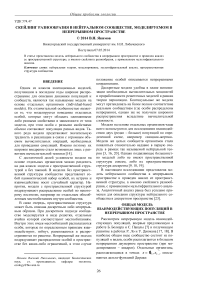Скейлинг разнообразия в нейтральном сообществе, моделируемом в непрерывном пространстве
Автор: Якимов Василий Николаевич
Журнал: Известия Самарского научного центра Российской академии наук @izvestiya-ssc
Рубрика: Общие проблемы экологии
Статья в выпуске: 5 т.16, 2014 года.
Бесплатный доступ
В статье представлена модель нейтрального сообщества в непрерывном пространстве и проведен анализ ее пространственной структуры, а именно скейлинга разнообразия, с применением мультифрактального анализа.
Нейтральная теория, моделирование, мультифрактальный анализ, пространственная структура сообщества
Короткий адрес: https://sciup.org/148203306
IDR: 148203306
Список литературы Скейлинг разнообразия в нейтральном сообществе, моделируемом в непрерывном пространстве
- Гелашвили Д.Б., Иудин Д.И., Розенберг Г.С., Якимов В.Н., Солнцев Л.А. Основы мультифрактального анализа видовой структуры сообщества//Успехи соврем. биол. 2008. Т. 128. № 1. С. 21-34.
- Гелашвили Д.Б., Иудин Д.И., Розенберг Г.С., Якимов В.Н., Солнцев Л.А. Фракталы и мультифракталы в биоэкологии: Монография. Нижний Новгород: Изд-во Нижегородского университета, 2013. 370 с.
- Гиляров А.М. В поисках универсальных закономерностей организации сообществ: прогресс на пути нейтрализма//Журн. общ. биол. 2010. Т. 71. С. 386-401.
- Иудин Д.И., Гелашвили Д.Б., Розенберг Г.С. Мультифрактальный анализ структуры биотических сообществ//Докл. РАН. 2003. Т. 389. № 2. С. 279-282.
- Arrhenius O. Species and Area//J. Ecol. 1921. Vol. 9. P. 95-99.
- Bhattacharjee S.M., Seno F. A measure of data collapse for scaling//J. Phys. A: 2001. Vol. 34. P. 6375-6380.
- Bolker B., Pacala S.W. Using Moment Equations to Understand Stochastically Driven Spatial Pattern Formation in Ecological Systems//Theor. Popul. Biol. 1997. Vol. 52. P. 179-197.
- Borda-de-Agua L., Hubbell S.P., McAllister M. Species-Area Curves, Diversity Indices, and Species Abundance Distributions: A Multifractal Analysis//Am. Nat. 2002. Vol. 159. P. 138-155.
- Cencini M., Pigolotti S., Muñoz M.A. What Ecological Factors Shape Species-Area Curves in Neutral Models?//PLoS ONE. 2012. Vol. 7. P. e38232.
- Chave J., Muller-Landau H.C., Levin S.A. Comparing classical community models: theoretical consequences for patterns of diversity//Am. Nat. 2002. Vol. 159. P. 1-23.
- Etienne R.S., Apol M.E.F., Olff H., Weissing F.F. Modes of speciation and the neutral theory of biodiversity//Oikos. 2007. Vol. 116. P. 241-258.
- Evertsz C.J.G., Mandelbrot B.B. Multifractal measures//Chaos and fractals: new frontiers of science (Eds. Peitgen H.-O, Jurgens H., Saupe D.). New York: Springer, 1992. P. 921-953.
- Gillespie D.T. A general method for numerically simulating the stochastic time evolution of coupled chemical reactions//J. Comp. Phys. 1976. Vol. 22. P. 403-434.
- Grimm V., Railsback S.F. Individual-based Modeling and Ecology. Princeton: Princeton Univ. Press, 2005. 480 pp.
- Harte J., Kinzig A., Green J. Self-Similarity in the Distribution and Abundance of Species//Science. 1999. Vol. 284. P. 334-336.
- Hubbell S.P. The unified neutral theory of biodiversity and biogeography. Princeton: Princeton Univ. Press, 2001. 375 pp.
- Law R., Dieckmann U. A dynamical system for neighborhoods in plant communities//Ecology. 2000. Vol. 81. P. 2137-2148.
- Law R., Murrell D.J., Dieckmann U. Population growth in space and time: spatial logistic equations//Ecology. 2003. Vol. 84. P. 252-262.
- Rosindell J., Cornell S.J. Species-area relationships from a spatially explicit neutral model in an infinite landscape//Ecol. Let. 2007. Vol. 10. P. 586-595.
- Rosindell J., Hubbell S.P., Etienne R.S. The Unified Neutral Theory of Biodiversity and Biogeography at Age Ten//Trends Ecol. Evol. 2011. Vol. 26. P. 340-348.
- Tjørve E. Shapes and functions of species-area curves: a review of possible models//J. Biogeogr. 2003. Vol. 30. P. 827-835.
- Tjørve E. Shapes and functions of species-area curves (II): a review of new models and parameterizations//J. Biogeogr. 2009. Vol. 36. P. 1435-1445.
- Yakimov B.N., Iudin D.I., Solntsev L.A., Gelashvili D.B. Multifractal analysis of neutral community spatial structure//J. Theor. Biol. 2014. Vol. 343. P. 44-53.
Статья научная


